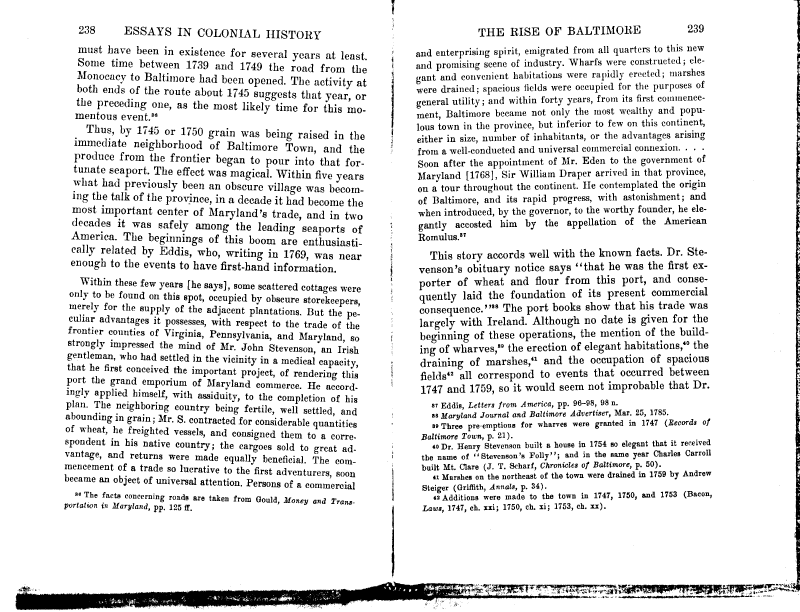|
238 ESSAYS IN COLONIAL HISTORY
must have been in existence for several years at least.
Some time between 1739 and 1749 the road from the
Monocacy to Baltimore bad been opened. Tbe activity at
both ends of the route about 1745 suggests that year, or
the preceding one, as the most likely time for this mo-
mentous event.86
Thus, by 1745 or 1750 grain was being raised in the
immediate neighborhood of Baltimore Town, and the
produce from the frontier began to pour into that for-
tunate seaport. The effect was magical. Within five years
what had previously been an obscure village was becom-
ing the talk of the province, in a decade it had become the
most important center of Maryland's trade, and in two
decades it was safely among the leading seaports of
America. The beginnings of this boom are enthusiasti-
cally related by Eddis, who, writing in 1769, was near
enough to the events to have first-hand information.
Within these few years [he says], some scattered cottages were
only to be found on this spot, occupied by obscure storekeepers,
merely for the supply of the adjacent plantations. But the pe-
culiar advantages it possesses, with respect to the trade of the
frontier counties of Virginia, Pennsylvania, and Maryland, so
strongly impressed the mind of Mr, John Stevenson, an Irish
gentleman, who had settled in the vicinity in a medical capacity,
that he first conceived the important project, of rendering this
port the grand emporium of Maryland commerce. He accord-
ingly applied himself, with assiduity, to the completion of his
plan. The neighboring country being fertile, well settled, and
abounding in grain; Mr. S. contracted for considerable quantities
of wheat, he freighted vessels, and consigned them to a corre-
spondent in his native country; the cargoes sold to great ad-
vantage, and returns were made equally beneficial. The com-
mencement of a trade so lucrative to the first adventurers, soon
became an object of universal attention. Persons of a commercial
s« The facts concerning roads are taken from Gould, Money and Trans-
portation in Maryland, pp. 125 ff.
THE RISE OF BALTIMORE
239
and enterprising spirit, emigrated from all quarters to this new
and promising scene of industry. Wharfs were constructed; ele-
gant and convenient habitations were rapidly erected; marshes
were drained; spacious fields were occupied for the purposes of
general utility; and within forty years, from its first commence-
ment, Baltimore became not only the most wealthy and popu-
lous town in the province, but inferior to few on this continent,
either in size, number of inhabitants, or the advantages arising
from a well-conducted and universal commercial connexion. . . .
Soon after the appointment of Mr. Eden to the government of
Maryland [1768], Sir William Draper arrived in that province,
on a tour throughout the continent. He contemplated the origin
of Baltimore, and its rapid progress, with astonishment; and
when introduced, by the governor, to the worthy founder, he ele-
gantly accosted him by the appellation of the American
Romulus."
This story accords well with the known facts. Dr. Ste-
venson's obituary notice says "that he was the first ex-
porter of wheat and flour from this port, and conse-
quently laid the foundation of its present commercial
consequence."88 The port books show that his trade was
largely with Ireland. Although no date is given for the
beginning of these operations, the mention of the build-
ing of wharves,"9 the erection of elegant habitations,40 the
draining of marshes,41 and the occupation of spacious
fields42 all correspond to events that occurred between
1747 and 1759, so it would seem not improbable that Dr.
87 Eddie, Letters from America, pp. 96-98, 98 n.
>8 Maryland Journal and Baltimore Advertiser, Mar. 25, 1785.
»• Three pre-emptions for wharves were granted in 1747 (Records of
Baltimore Town, p. 21).
*o Dr. Henry Stevenson built a house in 1754 so elegant that it received
the name of "Stevenson's Folly"; and in the same year Charles Carroll
built Mt. Clare (J. T. Scharf, Chronicles of Baltimore, p. 50).
«i Marshes on the northeast of the town were drained in 1759 by Andrew
Steiger (Griffith, Annals, p. 34).
*2 Additions were made to the town in 1747, 1750, and 1753 (Bacon,
Laws, 1747, ch. ixi; 1750, ch. li; 1753, ch. xi).
|

